Market Trends of Military Aircraft Avionics Industry
The Flight Control Systems Segment to Dominate the Market During the Forecast Period
A military aircraft's flight control system (FCS) consists of hardware and software systems for cockpit flight controls, such as data acquisition systems, autopilot, flight recorders, active inceptor systems, and aircraft management computers. Currently, the flight control systems in military aircraft are developed based on fly-by-wire (FBW) technology. The rising geopolitical tensions across various regions have compelled defense forces to enhance their combat capabilities. Many countries have increased their defense budgets to strengthen their military capabilities, driving the demand for military aircraft and UAVs.
Additionally, aircraft OEMs have partnered with avionics OEMs to develop and equip advanced flight control systems in new-generation aircraft. Also, key players are focusing on integrating next-generation technologies such as big data analytics and artificial intelligence (AI) into computers to enhance the autonomous operations of human-crewed and uncrewed aircraft. For instance, in January 2023, France granted Thales and Sabena Technics a contract to upgrade the CN-235 military transport fleet of the French Air and Space Force. Once the upgrade is done, the CN-235 fleet will be operational through 2040. Similarly, in March 2024, Canada's Department of National Defence (DND) awarded Arcfield Canada a contract to provide avionics in-service support for the CF-18 fleet for USD 157 million. Such developments are expected to accelerate the market's growth during the forecast period.

North America Expected to Exhibit the Largest Market Share During the Forecast Period
North America is expected to emerge as the dominant regional player in the market. The demand for military aircraft avionics significantly increased in the United States in recent years due to various factors such as the rise of global conflicts, growing geopolitical tensions, terrorism, and the increasing capabilities of potential adversaries of the United States.
The US government has invested heavily in technological platforms to enhance its defense capabilities. For instance, in 2023, the US military defense expenditure rose to USD 916 billion, a growth of 2.3% compared to 2022. Rising investments in advanced weaponry are due to the increasing threat to the country from Russia and China on the battlefield. With this increased military expenditure, the US Department of Defense (US DoD) is working to modernize and expand the country's regional defense forces capabilities.
For instance, in February 2024, the US Army awarded Triumph Group a contract to upgrade the EMC32T Hydraulic Metering Assembly (HMA) fuel control on the T55 engines for the CH-47 Chinook helicopter fleet. Triumph will overhaul more than 100 EMC32T HMAs each year from 2024 to 2028 to ensure they meet the latest standards. Similarly, in March 2024, the Naval Air Systems Command awarded Boeing a contract to build 17 new F/A-18 Super Hornet jet fighter bombers, sensors, and avionics for USD 1.4 billion. The Super Hornet features an active electronically scanned array (AESA) radar, large cockpit displays, and a joint helmet-mounted cueing system. Such investments by countries in North America to enhance their aerial capabilities are anticipated to propel the growth of the market over the coming years.


